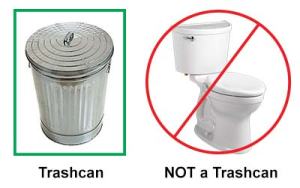To flush or not to flush, that is the question…
We know that the toilet can sometimes seem like a magical trashcan, instantly transporting things it might otherwise be more difficult to get rid of. Out of sight, out of mind; not your problem anymore, right?
But the reality is that all the stuff being flushed down is actually going SOMEWHERE – and often that ‘somewhere’ is just around the next bend to start a new clog in your home’s plumbing system or the city sewer system to join with other unflushables in wreaking havoc further down the line.
So, what can you do to help ensure your toilet remains clog-free, reduce the risk of damage to water treatment facilities or municipal sewer systems, and minimize the effects of our sewers on the environment? It’s really quite simple: there are only two things any toilet was designed to flush – human waste and toilet paper. If it isn’t one of those two things, don’t flush it. Couldn’t be easier, right?
But what about all those products that say they’re perfectly fine to flush? Well, they’re not. Our sewer systems simply weren’t designed to handle the materials these modern “flushable” items are made of. Flushable wipes don’t break down the same way toilet paper does, so while they might not cause a clog right away, they do have a tendency to catch other items and act as the building blocks for major blockages. The same goes for flushable cat litter. Sure, it sounds like a sensible idea, but clay is just naturally not suited to travel through pipes. All it takes is one clump getting stuck to create a big problem for your home, your neighbors’ homes, or even your whole town.
The 10 things people flush that should never be flushed:
- As previously mentioned, baby wipes – of any kind, including the “flushable” toddler or adult wipes – paper towels, napkins, or any other “paper” product that isn’t toilet paper
- Cotton balls, cotton swabs, cigarette butts, fabric softener/dryer sheets, or similar fibrous materials
- Hair (ladies and gents with long hair, please use a trashcan when you clean out your brushes!)
- Cat litter, even the “flushable” kind
- Condoms – they basically inflate like balloons and can be a fairly destructive obstruction (oh, and don’t flush balloons either!)
- Band-aids and dental floss – these both tangle up with small clogs to turn them into big clogs
- Prescription medications and cosmetics – while anything that goes in or on your body might seem safe, these items can be potentially toxic to wildlife and/or leach into our drinking water. Many pharmacies will “take back” leftover medications – check with yours, a local hospital or the public health authority for similar disposal programs
- Tampons, maxi pads, other feminine hygiene products
- Razors, blades, syringes, needles, etc. – these can cause serious injury to municipal sewage/wastewater workers and to wildlife, contact your local pharmacy or public health authority for safe ways to dispose of this type of item
- Gum…it seems fairly obvious that something that is basically a sticky ball will get hung up somewhere
It’s important to understand that minor clogs can happen no matter how diligent you are – but the risk of a highly damaging, expensive to deal with clog in either your home or the municipal sewage system is GREATLY reduced by only flushing appropriate things and properly maintaining your toilet. Save money, be a good citizen, and help take care of our sewage systems!
Check out more information about improving toilet performance, toilet repair parts, and ways to deal with clogs.






#
#
A toilet in an institution for the elderly frequently needs plunged. The elder has been blamed for using excess toilet paper. is excess toilet paper the main reason for toilet clogging or cold there be other maintenance issues?